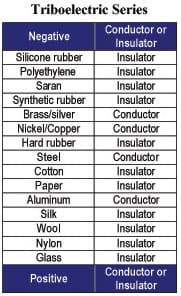Materials List:
Build a Charge Detector
 https://www.teachengineering.org/activities/view/cub_electricity_lesson02_activity2
https://www.teachengineering.org/activities/view/cub_electricity_lesson02_activity2
Each student needs:
- a square of aluminum foil (about 10 cm by 10 cm)
- a wide-mouth glass or plastic jar (ask students to bring from home)
- thin cardboard, larger than the jar opening (ask students to bring cereal boxes from home)
- silver foil from a candy bar (ask students to bring from home)
- a pair of scissors
- a balloon
- rigid, bare wire (10-15 cm) or unbend a paper clip
- scotch tape
- pairs of items, such as wool and nylon, from the Triboelectric Series Reference Sheet (see Figure 1)
- Charge Detector Graphing Worksheet (optional math component)
For the entire class to use:
- few cups or bowls of warm water for soaking candy bar wrappers that have a paper backing
- a few pieces of wool (available at fabric stores)
- a few large sewing needles (to poke holes into the cardboard)
- small pliers (may be necessary to bend the wire)
- a few bar magnets (optional, for the activity introduction)

 https://www.teachengineering.org/activities/view/cub_electricity_lesson02_activity2
https://www.teachengineering.org/activities/view/cub_electricity_lesson02_activity2